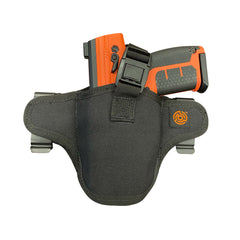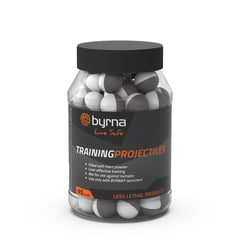
Older adults face safety problems every single day. The AARP reports that 3.2 million seniors feel unsafe when they step outside alone, and this number continues to grow over time. Those crowded streets, sidewalks, and drivers who rush through crosswalks can push that anxiety even higher for anyone. You might feel nervous yourself. That's also the case after dusk when shadows lengthen.
You don't need brute strength or moves to look after yourself anymore. The right gear can go a long way for an 82-year-old who still enjoys an evening walk or a quick trip to the market down the street. Look for items that back you up when trouble arises, match your mobility needs, and keep your hands free for bags, a cane, or a walker at all times. A lightweight device you can slip into a pocket is much easier to manage than heavy equipment that slows you down when moving.
Here are four tested ways to guard yourself without deadly force while you stay square with the law in any situation. Keep reading, and you'll see how a few helpful options can improve your confidence every time you leave the house on your own.
Table of Contents
1. Pepper Spray Systems
Pepper spray remains one of the most trusted tools for seniors who want non-lethal defense. Our products at Byrna especially work well here because of our high quality and reputation.

This small spray relies on a concentrated irritant that stops attackers fast. You might feel more protected because the container fits in a purse or coat pocket and gives you a ready option that avoids deadly force.
Manufacturers spent years improving the design for older hands. Wider grips, textured buttons, and bigger safety switches help you press the trigger even if arthritis limits strength. Some newer versions add small LED lights so you see the target and place the stream where it counts in low light.
Some seniors go with gel formulas instead of the classic mist - or even better, pepper projectiles for range and to avoid the risk of blowback. The thicker gel sticks to the face and nose, not the air. This cuts blowback and works better in the wind.
Always check the local laws before you buy. A quick look at state codes helps you avoid surprise fines. California caps each can at 2.5 ounces, while Massachusetts asks you to buy through a licensed firearms dealer. These legal limits protect public safety, yet still let you defend yourself.
Drill with the unit after you bring it home. We want you to go out to the yard, draw the can from your purse, flip the safety, then press. We recommend you do this set of moves a few times and fix the sequence in muscle memory.
Practice trims reaction time and helps you act with steady nerves when stress hits.
2. Electronic Protection Devices
Stun guns and personal alarms give seniors the discreet protection they can trust each day. A few of these designs blend into your activities, so you stay prepared without drawing any eyes.
The fob version attaches to your keys and looks just like a car remote. We all know that disguise is ready for the time you need it while adding almost no weight to your pocket.
You should pick a style you already know how to use. When the grip and buttons feel natural, you're likely to remain calmer and act faster. A dual-job flashlight stun gun does two jobs - it works as a normal light that guides you along a dark walkway and a strong defense within quick reach.
The sleek pen model looks no different from a standard writing pen. You can slip it into a pocket or a purse, and no one will guess you have a protection device until you press the switch.

While you browse different models, hold each one in your hand. Ask yourself if you can grab it fast, if the surface feels steady, and if the controls make sense. How you use it usually matters more than extra features.
The battery life changes quite a bit from brand to brand. Some units sit ready for months, but others need you to charge them every couple of weeks. You should always make a habit of testing the battery so you never face a dead device at a bad time.
The laws for stun guns change across different states. Areas allow them with no limits. But a few forbid them outright. Always check local statutes before you buy so you stay away from legal problems. Just last year in Phoenix, a Birdie alarm proved its worth in action. Three older neighbors set off their devices all at once, and the piercing sound sent a suspicious visitor running down the street.
Even the best electronic tool can fail. Low temperatures drain batteries, and excess moisture can hurt circuits quite a bit - keep this in mind when you map out your personal safety plan. People should always pack a spare power cell in their bag, the same way you might toss in an extra pair of glasses. We find that it's an easy step that can really help when you least expect it.
3. Tactical Everyday Items
These self-defense weapons give you a helpful way to defend yourself while you go about your usual errands. Lots of older adults already use a cane, so consider picking one that gives another layer of safety - it fits right into the life you already lead without extra effort.
When you use products as safety gear, these tools let you stay steady on your feet and ready to push back if something goes wrong. This approach gives you more confidence without drawing attention.
A reinforced tactical cane is a helpful example. When built from aircraft-grade aluminum and fitted with a soft grip, it keeps you stable as you walk, yet stands ready if someone steps too close. To passers-by, it looks like any other cane, so you preserve your sense of security without the spotlight.

You might also like a tactical pen - it writes your grocery list like every other pen. But the strengthened barrel gives you some weight you can use if you need to. You can slip it into a shirt pocket or purse, and no one will think twice.
Your weather gear can play a similar role. The Unbreakable Umbrella weighs under two pounds and shrugs off hard hits, so you can carry it whenever clouds threaten and never look out of place.
The keychain stun guns stay just as discreet. They clip onto the ring that already holds your house keys, and most people will assume they're just another car remote.
Some seniors also wear defensive jewelry. The rings or bracelets with hardened edges look nice, yet they hide features that can get you out of danger in a pinch.
Before you buy any of these tools, do check local rules. Some places restrict particular sizes or materials, and you don't want a safety plan that gets you into legal problems.
After you read the rules, try to match the tool to your life. If a pen feels too heavy to write comfortably, look elsewhere. If a cane won't fit next to the driver's seat, skip it. Choose gear that fits into your schedule so you'll actually carry it with you.
4. Self-Defense Training
You have far better self-defense options than you might expect. Cane Fu teaches you to turn a plain walking cane into a helpful shield. You stay steady on your feet while holding a tool that can push danger away.
Almost all older adults finish these targeted classes with a real sense of success and accomplishment.
More focused age-appropriate self-defense improves your confidence during errands and outings. Each lesson shows moves that fit common age-related limits, so you avoid strain throughout sessions. As you run the drills, you start to feel that the skills work. That fresh confidence follows you out the door.
These techniques match your strength without fighting it. You use positioning or body placement instead of brute force.
Tai Chi is another strategy if you want gentle motion. The sets build balance and coordination without harsh pressure on your joints. Teachers show how the same body mechanics can slip into a self-defense move when needed.

These programs focus on situations you could face in real life. You practice how to step back, angle your body, and create space from a possible threat until the actions feel automatic.
Small personal alarms and situational awareness add a second line of defense. The smartest move is to steer clear of danger if possible. Instructors point out early warning signs so you can leave before problems grow.
Most classes adjust to mobility levels, and some even run seated self-defense sessions for anyone with difficulty standing. The goal isn't to crown you a martial arts champion. It's to give you workable tools for normal circumstances.
Standard partner drills cement the motions into your muscle memory. Many students say they feel safer just walking to their car after a session. The shared group setting can add a welcome social lift as well.
We should keep in mind that every skill needs steady practice to stay sharp. The body can freeze under real stress, so take refresher courses often to lock the skills in place.
Your Path to Everyday Protection
You stay safer when you use more than one protection tool, because each one covers a small gap left by another. Always recognize your weak points so you can pick gear that fits your activities. Sometimes pepper spray keeps possible threats at arm's length, and a small electronic alarm can call for help or stun a threat for a few seconds - it feels natural to slip these items into a pocket or bag. Even a sturdy flashlight or cane can double as a defensive tool. Training ties the whole kit together by showing you the right time and way to act.
Before you buy any gear, pause and match the tool to your abilities and check local laws so you stay within legal boundaries. I recommend gear you can reach fast and use with steady hands. The right fit improves your confidence whenever you see an uncertain situation. In my experience, practice turns every device into second nature. A few community centers run safety classes for older adults, where you can try out different tools before you spend a dime, and most welcome anyone who wants to learn.
You never need to sort out a safety plan in isolation. Contact senior centers, talk with community officers, and invite close family to help you test gear and choose what fits your lifestyle. Your well-being deserves that bit of attention. With the right tools and knowledge, you can move through life with confidence.
When you know you have a plan and the skills to handle surprises, you breathe easier. You can walk out the door with less worry, ready to make the most of your day instead of trimming your schedule. Lots of seniors now tell me they wish they had acted sooner on personal safety, not because danger found them. It's true because fear trimmed too many valuable years.
That extra sense of security tends to steer every small choice. You can comfortably try a new path for your walk, start conversations with neighbors, maybe plan a weekend trip - all with calm assurance that you can manage what pops up.

To back up that confidence, just look at our less lethal protection. The proven design fires reliably under stress, so you can trust each trigger pull. Our launchers and armored backpacks stay legal in all 50 states and need no background check, removing paperwork hassles. A patented pull-pierce CO2 system keeps the unit charged until you press the first shot, so you prevent delays when seconds count. Tens of thousands of users carry our gear now and report steady confidence.
Visit our website at Byrna.com to see the full line and consider if one of these tools fits your life.




